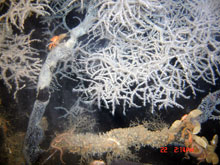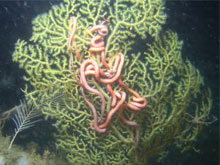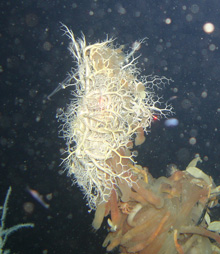Two thick branches arise from the base of a large black coral colony about 1.5 meters tall at 300 meters depth in the Gulf of Mexico. Gooseneck barnacles and squat lobsters (bright red) can be seen on the lower right and left of middle. Click image for larger view and image credit.
High-diversity hard bottom habitat at 300 meters depth in the Gulf of Mexico.
![]() Click image to view a video slideshow.
Click image to view a video slideshow.
Deep Island Oasis
September 22, 2008
Peter Etnoyer
Doctoral Fellow
Harte Research Institute, Texas A&M University-Corpus Christi
One of the primary reasons we are interested in deep-sea corals in the Gulf of Mexico is because these corals provide habitat for numerous associated species of fish and invertebrates. But not all corals are created equal. Some corals grow shallow, some grow deep, and some corals provide more habitat than others. Antipatharian (black) corals in particular are better known as providers of jewelry than they are as providers of habitat.
However, today we came across a good example of a large black coral providing habitat for fish and invertebrates at 300 meters depth. By our estimates, the colony was about 1.5 meters high and 3 meters across. Drawing from other studies, we estimate the age of the colony to be 500 years or greater. We were careful to collect only a small piece for genetic analyses in order to preserve the integrity of the colony.
Altogether, we counted about 50 gooseneck barnacles, two types of squat lobsters, and one large basket star living on the colony. Around the base of the colony, we noted five or more anemones, some large yellow crinoids, a spider crab, a scorpion fish, and two or three other fish. We did not observe some of these species in surrounding areas, so we assume they benefit from life on a coral tree.
An Astrophyton basket star is perched atop the black coral colony, surrounding a dozen gooseneck barnacles. Click image for larger view and image credit.
You may wonder what advantages a coral colony can provide to its inhabitants. First and foremost, the colony provides a “perch,” like trees do for birds. The height of the colony allows suspension feeders (here, barnacles and squat lobsters) to reach up into the water column to enhance their food supply. Other advantages include predator evasion, better gas exchange, and settlement substrate for brooding larvae.
The large black coral colony we discovered was attached to a carbonate boulder forced upwards through the surrounding sediment. It was an “island oasis” of habitat in an otherwise featureless plain. We seek to protect corals for precisely this reason: they are long-lived foundation species that support overall marine biodiversity in the Gulf of Mexico and beyond.
























